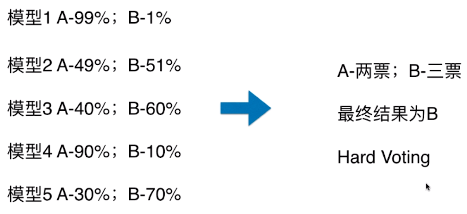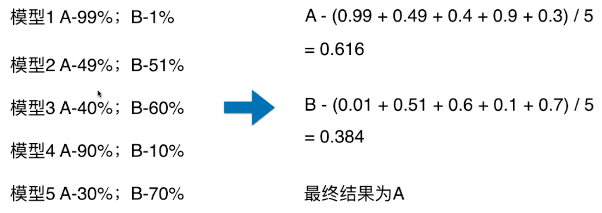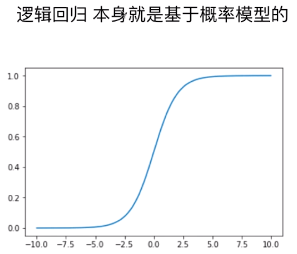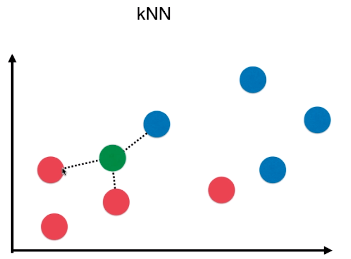机器学习:集成学习(Soft Voting Classifier)
2024-08-29 01:24:39
一、Hard Voting 与 Soft Voting 的对比
1)使用方式
- voting = 'hard':表示最终决策方式为 Hard Voting Classifier;
- voting = 'soft':表示最终决策方式为 Soft Voting Classifier;
2)思想
- Hard Voting Classifier:根据少数服从多数来定最终结果;
- Soft Voting Classifier:将所有模型预测样本为某一类别的概率的平均值作为标准,概率最高的对应的类型为最终的预测结果;
Hard Voting
- 模型 1:A - 99%、B - 1%,表示模型 1 认为该样本是 A 类型的概率为 99%,为 B 类型的概率为 1%;

Soft Voting
- 将所有模型预测样本为某一类别的概率的平均值作为标准;

- Hard Voting 投票方式的弊端:
- 如上图,最终的分类结果不是由概率值更大的模型 1 和模型 4 决定,而是由概率值相对较低的模型 2/3/5 来决定的;
二、各分类算法的概率计算
- Soft Voting 的决策方式,要求集合的每一个模型都能估计概率;
1)逻辑回归算法
- P = σ( y_predict )

2)kNN 算法
- k 个样本点中,数量最多的样本所对应的类别作为最终的预测结果;
- kNN 算法也可以考虑权值,根据选中的 k 个点距离待预测点的距离不同,k 个点的权值也不同;
- P = n / k
- n:k 个样本中,最终确定的类型的个数;如下图,最终判断为 红色类型,概率:p = n/k = 2 / 3;
3)决策树算法
- 通常在“叶子”节点处的信息熵或者基尼系数不为 0,数据集中包含多种类别的数据,以数量最多的样本对应的类别作为最终的预测结果;(和 kNN 算法类似)
- P = n / N
- n:“叶子”中数量最多的样本的类型对应的样本数量;
- N:“叶子”中样本总量;
4)SVM 算法
- 在 scikit-learn 中的 SVC() 中的一个参数:probability
- probability = True:SVC() 返回样本为各个类别的概率;(默认为 False)
from sklearn.svm import SVC
svc = SVC(probability=True) - 计算样本为各个类别的概率需要花费较多时间;
三、scikit-learn 中使用集成分类器:VotingClassifier
1)模拟数据集
import numpy as np
import matplotlib.pyplot as plt
from sklearn import datasets
from sklearn.model_selection import train_test_split X, y = datasets.make_moons(n_samples=500, noise=0.3, random_state=42)
X_train, X_test, y_train, y_test = train_test_split(X, y, random_state=42)
2)voting = 'hard':使用 Hard Voting 做决策
from sklearn.linear_model import LogisticRegression
from sklearn.svm import SVC
from sklearn.tree import DecisionTreeClassifier
from sklearn.ensemble import VotingClassifier # 实例化
voting_clf = VotingClassifier(estimators=[
('log_clf', LogisticRegression()),
('svm_clf', SVC()),
('dt_clf', DecisionTreeClassifier(random_state=666))
], voting='hard') voting_clf.fit(X_train, y_train)
voting_clf.score(X_test, y_test)
# 准确率:0.896
3)voting = 'soft':使用 Soft Voting 做决策
voting_clf = VotingClassifier(estimators=[
('log_clf', LogisticRegression()),
('svm_clf', SVC(probability=True)),
('dt_clf', DecisionTreeClassifier(random_state=666))
], voting='soft') voting_clf.fit(X_train, y_train)
voting_clf.score(X_test, y_test)
# 准确率:0.912- 使用 Soft Voting 时,SVC() 算法的参数:probability=True
最新文章
- 项目vue2.0仿外卖APP(六)
- Django 中related_name,"%(app_label)s_%(class)s_related"
- git的一些命令行
- Sublime Text的常用插件
- Jenkins的安装与配置
- 机器学习之Hash集合问题
- stdout.read()与stdout.readlines()方法同时使用后果
- ZOJ3550 Big Keng(三分)
- jdk配置环境变量(windows)
- 实战 Spring MVC接入支付宝即时到账 (部分代码)
- Python第二天课程
- XManager5连接CentOS7
- iOS-Runtime之关于页面跳转的捷径【Runtime获取当前ViewController】
- dp之背包总结篇
- 关于thinkphp5URL重写
- 使用perconna xtrabackup备份脚本
- 50个最常用的Linux命令
- 自制操作系统Antz(6)——内核初步,引入c语言
- ADO.NET 的五个对象
- P2512 [HAOI2008]糖果传递
